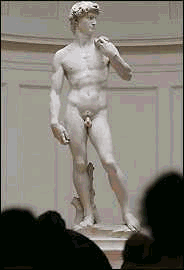Michelangelo
Buonarotti was born in Florence in 1475 and died there in 1564. He is one of the greatest artists in the history of the world. Although his
passion was for carving marble, he also distinguished himself an
exceptional painter and architect. In these fields, we can name two great
works: the Sistine Chapel ceiling and St. Peter's Cathedral.
To
Michelangelo, sculptures were the "making of men." His emphasis
on the human form and content is displayed in all his work; the roundness
and organic qualities of the man's body is revealed in his sculptures,
painting, and architecture. Michelangelo's approach to sculpture is to
liberate the human body that was encased into the cold marble. This
conviction and attention to details produced one of the largest and most
powerful statues of the Renaissance: "David."

In
1501, the City of Florence commissioned Michelangelo to create a statue to
be placed high above Florence on one of the Cathedral fortresses.
Michelangelo produced "David" at the age of 26. The City of
Florence deemed "David" a civic patriotic symbol and placed it
in front of the Palazzo Vecchio.
Michelangelo
was fiercely patriotic to his city-state; in fact, he considered himself a
Florentine, not an Italian. In choosing "David" as the subject
of his work, he incorporated in the size of the marble and the style of
the statue the many symbols reflecting his allegiance to Florence. The
size of "David" represented the victorious struggle of his City
to become an independent city-state. It was the symbol of freedom, and it
represented the Republic of Florence.
Michelangelo
saw three reasons for the size of the statue. First, it was representative
of Florence's independence and beauty. Second, it was the first sculptural
reference for Florence, which he considered similarly to be large scale.
And third, the Renaissance humanistic theory and style were to celebrate
the human form on a grandiose proportion.
The
artist used the Hellenistic super human beauty and power, which impressed
him on a trip to Rome. The S-shaped curve of "David" combines
balance and grace, strength and power. The statue, nineteen feet in
height, powerful and victorious, is a symbol of Florentine history and its
struggle for political and artistic freedom. In its expression, the full
nude marble is a classical tribute to antiquity.
